
(auf Karte anzeigen)
12:15UTC+2

13.08.201911:45UTC+2
Panama Canal Transit by Sailboat
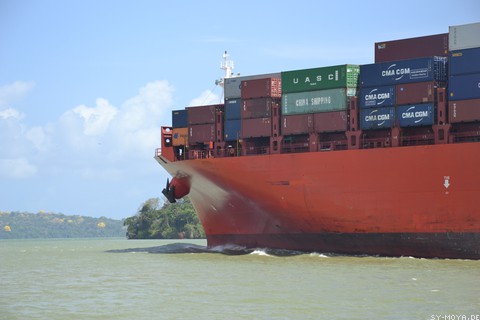
Summary
Sailing vessel Moya and her crew transited the panama canal southbound from the Atlantic ocean and arrived one day later in the Pacific. We, a family with two little boys aged 3 and 5 organized our transit without an agent. 15 days after the initial inspection we transited the canal, but could have expedited the process by at least four days. Everyone we talked to was highly professional, efficient and very supportive. We herein describe our experience in organizing the transit as well as the transit itself through the canal. The transit was a very interesting experience, which we enjoyed a lot in most parts.
Agent vs. Do it yourself
As we are traveling with two little kids and basically don’t speak Spanish, we initially have been very hesitant to organize our transit without agent. Another concern was security in the town of Colon.
We contacted agents who offered services for 350-450 USD and informed ourselves about transiting procedures at the same time (experience reports on noonsite and Panama Canal. Since experience of cruisers organizing the transit themselves was consistently very straight forward even if no Spanish was spoken and since the town of Colon only needs to be visited once for transit payment or not at all if payment is done via wire transfer, we decided to save some money and organize the transit ourselves.
Transit organization was not a big deal at all and even with two little ones easily doable. Despite making the transit payment only one email and a couple of phone calls need to be conducted. We directly communicated with officers of the canal authority, all of whom speaking English well, have been very supportive and very efficient at the same time. The only disadvantage of the doing it yourself in our opinion is that you initially need to pay a deposit, which is refunded later and is not required if things are managed by an agent. However, there is also a big advantage by managing the transit directly with the canal authority, which is time. If you are in a hurry and would like to transit as soon as possible and are flexible, it is possible to call the authority multiple times after having a preliminary transit date and ask again for short notice transit slots. As sailing vessels lock together with small commercial vessels and the locking schedule is only fixed one day before lockage even for freighter, short notice transit slots seem to be available regularly (two even have been offered to us, which we could not manage to confirm). Taken together, scheduling and managing a canal transit without an agent is efficient, not a lot of work, easily doable even when not speaking Spanish and may shorten waiting time until transit.
Organizing a Canal Transit without an agent
Procedures for our transit have been very straight forward and are described in detail on the website of the canal authority: Procedures for securing a handline transit. Our experience is detailed below.
1. REQUEST FOR HANDLINE INSPECTION AT THE ADMEASUREMENT OFFICE.
We filled out the request for handline inspection form 4405 and sent it via email to the admeasurer office (email address: optc-ara@pancanal.com)
2. RECEIVE DATE FOR ADMEASUREMENT.
We called the admeasurer office (number specified on form 4405) directly after sending form 4405, received confirmation that the form was obtained and scheduled an appointment for admeasurement two days after at the Flats anchorage in Colon. It was a 5 min phone call, the officer spoke good english. Admeasurement can either be conducted at the Flats anchorage inside the breakwater of Colon port or at the Shelter Bay Marina.
3. RECONFIRM DATE OF ADMEASUREMENT ONE DAY PRIOR TO ADMEASUREMENT.
We reconfirmed our appointment via phone (number as specified on form 4405) the day before admeasurement.
STEPS 1-3) CAN BE CONDUCTED FROM OUTSIDE OF COLON
4. ADMEASUREMENT.
At the day of admeasurement the admeasurer was dropped by a pilot boat at the Flats anchorage as scheduled. He measured the length of the vessel, filled out all relevant forms (4 forms), supplied us with the ship identification number (SIN) valid for the life of the vessel and explained all transit procedures in detail (very nice person, spoke perfect english). We excluded side wall transit to exclude being tied up to rough concrete walls of the lock chambers and accepted everything else (center chamber = single boat in the middle of chamber secured by four lines, nested = up to three sailing boats tied together and held in the center of the chamber by two lines on the starboard and two lines on the port side, tug = attached to a tug boat). Please note - officially your vessel needs to be able to maintain 8 kts cruising speed, however admeasurer usually accepts if you can do more than 5 kts. 7 kts were ok for us.
5. PAYMENT.
We visited the Citibank in Colon located at the entrance of the piers (Calle 13) and made the payment (including deposit to be refunded after transit). There is no ATM in the Citibank but 3 buildings further down the street, multiple drawings were possible. Alternatively, we could have done a wire transfer, in this case there would have been no need to visit Colon at all (Side note: we tried to access Colon town via the club nautico, but security staff denied land access. Apparently there is some regulation that yachts are no longer allowed to enter town here or at the close by Cruiseship terminal)
6. RECEIVE TRANSIT DATE.
We called the canal authority (as specified on the document procedures for securing a handline transit) at the same day and received a preliminary transit date 15 days later (high season). Again good english was spoken. The officer offered that we could call as often as we liked, as they are often getting additional transit slots on short notice. As we still needed to do some maintenance work at the boat, we didnt call again until 4 days prior to our transit date and were offered an additional transit slot the next day, which we couldnt confirm as we couldn`t reschedule our line handers on short notice.
7. ORGANISE LINES AND FENDERS FOR TRANSIT.
4 lines 38 meters or longer are a prerequisite for transit. Whether sufficient fenders are available on board is the captians decision. Tito is specialised to rent lines and fenders (old car tires wrapped in plastic foil) for the canal transit. We called Tito (507/64635009) but couldn`t reach him initially. He called back after an hour and confirmed to rent out lines for 20 USD each and fenders for 3 USD each plus 20 USD transportation (speaks english well).
8. ORGANISE LINE HANDERS.
Four line handers are required for transit in addition of the vessels helm man. Line handers can either be hired from Tito (rates we do not know) or can be found asking other cruisers waiting for transit and looking for experience before transiting with their own vessel or backpackers with prior sailing experience. We needed 3 addition line handers all of whom we found by asking around in Portobello.
9. RECEIVE LINES AND FENDERS.
Tito dropped the lines and fenders at Portobello, where we anchored until the day prior to transit, at our request. In Colon the only possibility to anchor are the Flats (if you don’t like to visit shelter bay marina), which are secure but neither nice nor convenient as it’s within the industrial habour and going ashore is officially only possible by water taxi (15 USD each ride). We received for four strong lines and 10 tires. We figured during transit that the tires would have been not necessary, as we were tied to other sailing vessels and never had to touch chamber walls of the locks.
10. RECONFIRM TRANSIT DATE THE DAY PRIOR TRANSIT.
We again called the canal authority, who reconfirmed our transit for the next day. It is only possible to get the exact hour of transit the day prior to transit. Pilot boarding was scheduled to 2.30 pm. From now one we were required to repeatedly reconfirm our transit with Christobal signal station via VHF.
TRANSIT
1. MEALS FOR TRANSIT.
Water and meals need to be provided to the advisor (pilot) during the canal transit. Advisors usually only drink bottled water. If no proper food is provided advisors may order meals delivered by a costly express ferry at your costs. We therefor pre-cooked dinner for the first transit day and lunch for the second transit day at the day of transit. We also baked a cake as afternoon snack.
2. STANDBY PRIOR TRANSIT.
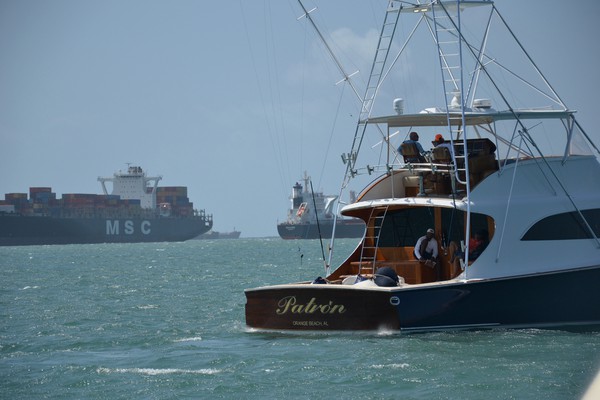 As we were required to moore in the Flats anchorage at least four hours prior to transit and to make sure to maintain contact with Christobal signal station, we anchored in the Flats already the night prior transit. Christobal signal station contacted us several times for transit confirmation.
As we were required to moore in the Flats anchorage at least four hours prior to transit and to make sure to maintain contact with Christobal signal station, we anchored in the Flats already the night prior transit. Christobal signal station contacted us several times for transit confirmation.
3. BOARDING OF LINE HANDERS.
Our line handers boarded the vessel four hours prior to transit in the Flats anchorage. The only possibility for boarding is a water taxi from Muele 5 in Colon to the Flats, as the Flats lie within the industrial harbour, which is restricted area and not accessible without relevant documents. After boarding the line handers were briefed by the captain and line handling was practiced.
4. BOARDING OF ADVISOR.
The pilot was dropped off by a pilot vessel at 3.30 pm. After a quick introductory round we were advised to lift the anchor and followed a commercial vessel towards the entrance of the locks. Besides our boat another sailboat and a powerboat, each with an own advisor, started their transit. Advisors constantly communicated with each other and the locks by VHF radio.
5. GATUN LOCKS.
Gatun Locks are three separate chambers in a row, each 150 feet wide and 1000 feet long. We waited approximately 45 minutes in front of the locks until car traffic crossing the locks resolved and the gates could be opened. After entrance of the commercial vessel, the powerboat entered the first lock and attached itself at the starboard side to the chamber wall. Once securely attached, we have been asked to tie up at the port side of the powerboat. Advisors made sure, that all lines (two springs, a bow and a aft line) were of sufficient dimension and attached very tight between the vessels. Thereafter the remaining sailing vessel attached itself accordingly at our port side. During this time the gates were closed. Water started to flood the chamber directly after the boats have been tied up. The canal authority is able to regulate the water flow into the chamber and can open all valves or valves only at the port or starboard side of the locks. In our case only valves were opened on the starboard side of the lock, which caused heavy turbulences in the water on the starboard side of the chamber. The boats were moving against each other and the lines have been under strong pressure. After the chamber was filled, gates opened to the middle chamber, the commercial vessel moved ahead while first the sailing vessel detached from our port side. As we are having no bow thruster and it was blowing 20 kts of wind into the locks, we used the bow spring to securely dismantle ourselves from the power vessel. The captain of the power vessel disliked the manoever as he was scared that his boat was prone to damage.
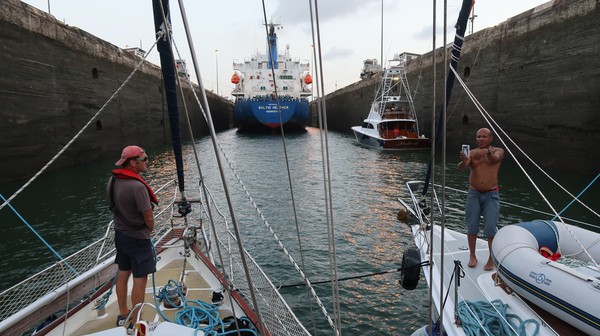
The powerboat then detached from the wall, moved into the second chamber after the freighter and attached itself again to the sidewall of the chamber. As in the first chamber we tied up to the powerboat and the sailing vessel attached to our port side. This time all valves were opened to release the water, which made locking more convenient with less turbulences. After the lock was filled with water boats detached. We tried to explain that it is more secure for all boats if we used the spring line to resolve ourselves and know from experience that there is a significant risk in damaging the powerboat in case we detach without a spring line. Then we securely detached ourselves from the power vessel supported by the spring line. This upset the captain of the powerboat and he refused to continue locking with sail boats attached.
Our advisor quickly organized line handers on the wall of the third chamber and asked us to re-organize our lines for center chamber lockage while moving into the third chamber. Restructuring between the locks is prohibited and was advised the first time in the career of our advisor (800 transits as advisor on sailboats), but was the only option left after refusal of the powerboats captain. We attached to the other sailing vessel while entering the third chamber and prepared two line on our port side for attachment to the chamber wall. The line handers on top of the chamber wall threw light line on top of the vessels to which we attached our robust lines. The lines where then hoisted on top of the chamber wall and attached. Both sailing vessels were now lying side by side in the center of the lock chamber, while the power boat attached again to the side of the wall between the commercial vessel and the sailing vessels. Gates closed and water started to flood the chamber. During flooding we were required to constantly adjust and tighten the lines from the boat. Once the lock was filled the gate opened, the boats moved into the lake Gatun and detached. Despite the re-organization action we felt that center chamber lockage was more relaxed compared to being attached to another vessel at the chamber wall.
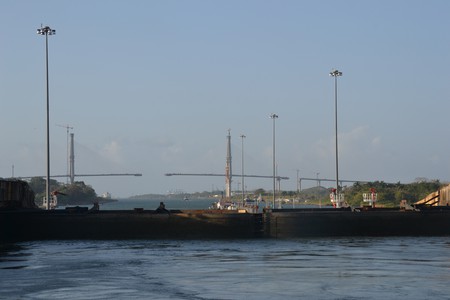
6. OVERNIGHT MOORING.
Dusk had settled already as we motored out of the locks, we passed the novel locks at our port side and attached Moya to a large mooring bouy. The advisor was picked up by a pilot boat after telling us that we will continue our transit at 6 am the next day. He didnt stay for dinner. We spend the night hearing howler monkeys and other jungle sounds which we couldnt identify.
7. RE-BOARDING OF ADVISOR.
With a delay of more than 1.5 hours the pilot boat dropped the advisor at 7.45 am. We detached ourselves and started the transit through the panama canal.
8. GATUN LAKE & CANAL TRANSIT.
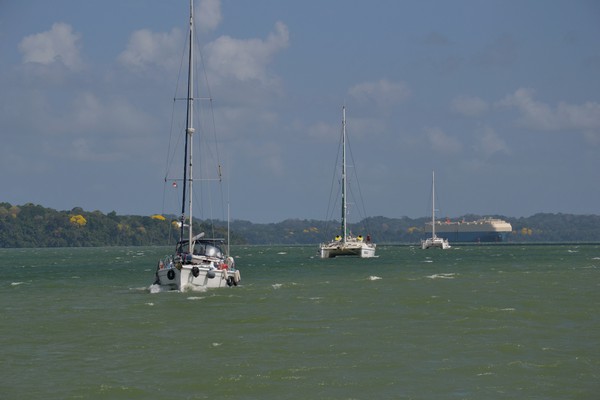 As we have been waiting for the advisor two more sailing vessels passed the Gatun locks. As a group of four sailboats we motored at the side of the bouyed channel. Along route we meet serval freighter and tug boats passing us from behind or from the front. Our advisor took care, that commercial vessels always had priority. Gatun lake was artificially flooded, therefore there are many small islands, which used to be the top of hills. The bouyed channel sometimes passed very close to the islands. Once we passed the lake, we stopped together with the other sailboats at a bouy. Our transit was delayed by one hour, since one freighter transiting to the atlantic side of the canal was stuck due to engine problems. Around noon we continued our transit through the canal itself, which was digged out from massive rocks when the canal was built. The channel here is more narrow as compared to the passage through the lake.
As we have been waiting for the advisor two more sailing vessels passed the Gatun locks. As a group of four sailboats we motored at the side of the bouyed channel. Along route we meet serval freighter and tug boats passing us from behind or from the front. Our advisor took care, that commercial vessels always had priority. Gatun lake was artificially flooded, therefore there are many small islands, which used to be the top of hills. The bouyed channel sometimes passed very close to the islands. Once we passed the lake, we stopped together with the other sailboats at a bouy. Our transit was delayed by one hour, since one freighter transiting to the atlantic side of the canal was stuck due to engine problems. Around noon we continued our transit through the canal itself, which was digged out from massive rocks when the canal was built. The channel here is more narrow as compared to the passage through the lake.
9. PEDRO MIGUEL LOCKS.
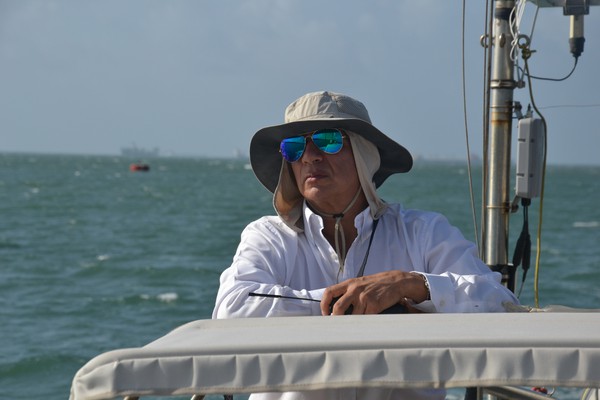 At 1.30 pm we tied up with two sailing vessels, us being on the port side. Similarly to yesterday two springs, a front and an aft line was used to tie the boats together. Together we moved into the single chamber of pedro miguel locks. Line handers at the lock passed two lines to our boat at the port side and accordingly two line to the starboard boat from the starboard side of the locks. We attached our heavy lines to the lines passed, which then were pulled back. Our lines were attached by the lines handers at the side of the lock. Once the commercial vessel entered gates closed and the water started to drain. We constantly took care to release our lines as we locked downwards. Once draining was completed, gates opened. As a bundle of three we moved out of the locks and also remained tied up for the short passage to the miraflores locks.
At 1.30 pm we tied up with two sailing vessels, us being on the port side. Similarly to yesterday two springs, a front and an aft line was used to tie the boats together. Together we moved into the single chamber of pedro miguel locks. Line handers at the lock passed two lines to our boat at the port side and accordingly two line to the starboard boat from the starboard side of the locks. We attached our heavy lines to the lines passed, which then were pulled back. Our lines were attached by the lines handers at the side of the lock. Once the commercial vessel entered gates closed and the water started to drain. We constantly took care to release our lines as we locked downwards. Once draining was completed, gates opened. As a bundle of three we moved out of the locks and also remained tied up for the short passage to the miraflores locks.
10. MIRAFLORES LOCKS.
The miraflores locks are at the pacific side of the canal and consist of two chambers. We entered the locks nested to the other boats. We again locked downwards in the center of the chamber similarly to the pedro miguel locks. 15.45 pm the gates of the second chamber opened, we moved for the first time into waters of the pacific and shortly after detached ourselves from the other boats. Thereafter we continued southbound and passed the bridge of Americas.
11. ADVISOR DROP-OFF.
Our Advisor Franklyn was picked up by a pilot vessel in front of the Balboa yacht club. We then proceeded to the anchorage.
12. PICK UP OF LINES.
Tito is able to pick up the lines at Balboa yacht club, Flamenco Marina, Playita Marina or Brisas. We anchored in front of the Playita Marina, where he picked up the lines two days after transit. He initially told us that he would also pick up the tires, but he didn`t. We dumped the tires at Playita Marina for a fee of 1 USD per tire.
Costs
- Canal Transit including all fees (vessel smaller 50 feet) - 964 USD
- Deposit - 891 USD refunded plus 25 USD for wire transfer of deposit
- Lines & Fenders - 155 USD
- Transportation lines handers - 75 USD
- Additionally costs for meals during the transit
- Total - 1250 USD